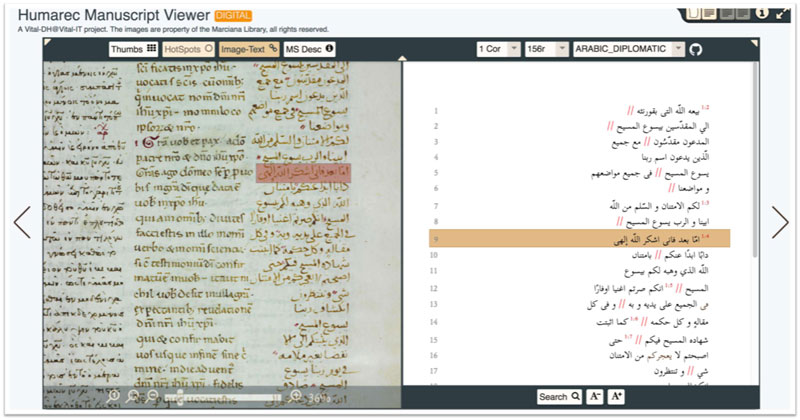by Claire Clivaz, Sara Schulthess and Anastasia Chasapi (SIB)
HumaReC, a Swiss National Foundation project, aims to test a new model of digital research partnership: from original document source to publisher. Its object of study is a trilingual, 12th century, New Testament manuscript, which is used by HumaReC to test continuous data publishing.
HumaReC [L1] is a Vital-DH@Vital-IT project funded by the Swiss National Foundation. Under the leadership of Claire Clivaz, it started in October 2016 and has been running for two years. The project is based at Vital-IT (Lausanne, CH), under the guidance of group leader Ioannis Xenarios from the Swiss Institute of Bioinformatics. The team is composed of a mixture of humanities and computing scholars; Sara Schulthess is the main researcher.
The aim of HumaReC is to investigate how humanities research is reshaped and transformed by the digital rhythm of data production and publication; it also aims to establish the best practices for Digital Humanities research. As a test-case, the study is focussed on a unique, trilingual New Testament manuscript: Marciana Gr. Z. 11 (379), written in Greek, Latin and Arabic. In the spirit of the OA2020 initiative [L4], continuous data publishing is being tested in partnership with all the research network stakeholders: the Marciana library (Venice, Italy), the Edition Visualization Technology (EVT) [L2], the Transkribus [L3] research teams, and the publisher Brill.
Rhythm is a central notion in the structure of HumaReC and we have chosen this key-concept, based notably on Meschonnic analysis [1], to observe the changes happening in digital humanities research which has been premised on printed culture for a long time. A two to three year research project in humanities has traditionally been characterised by the writing, editing and publication of a final, printed book, often delayed to a certain date after the end of the project. This delay was even considered proof of authentic, high-level research in humanities, certified by an established book series. The digital transition is creating a completely new research paradigm in part due to the publishing of formats such as videos, short messages or draft papers, social media and blogs, all before the research is even completed and peer-reviewed. How is it possible to develop certified and continuous data publishing digital research in the humanities?
As the project’s first step, a virtual research environment was created for HumaReC, allowing the research process and results to be made continuously available. It provides a manuscript viewer in fully open access that includes quality images of the manuscript and three columns of transcriptions (see Illustrations below). The manuscript viewer is based on EVT open source technology and is a development of a previous project’s viewer [2]. The improved viewer offers additional features such as linking between text and image. In addition to this, an annotation system will allow users to directly comment on the manuscript viewer. Secondly, Transkribus, a Handwritten Text Recognition tool, will also be tested by HumaReC: a certain number of words transcribed by hand allows a learning machine to be trained to recognise specific writing in a manuscript. The results are forthcoming: we will be able to compare the time taken by purely hand transcription with results produced by a human/machine team.
Finally, three publication formats were chosen for the continuous dissemination of the data:
- The virtual research environment itself; it received an ISSN (2504-5075) from the Swiss National Library: all the published material associated with the project can be referred to with this number. An international editorial board is providing project feedback and input on its research results.
- The research blog is an important interactive continuous publishing process. We regularly update the blog about the development of the project and the research results. We also encourage discussions by being present on social media (Facebook and Twitter).
- The web-book, continuously written in open access, summarises the research in a long, structured text, similar to a conventional monograph but related to the data. It is produced in partnership with the publisher Brill. At the end of the project, it will be peer-reviewed, and hopefully published with its own ISSN by Brill.
We are confident that HumaReC will establish a new research and publishing model, including potential commercial developments for all interested publishers.

Figure 1: Manuscript viewer f. 156r © Marciana Library all rights reserved.
Acknowledgement
Many thanks to Harley Edwards for his English proof-reading, to the Marciana library for the image copyright, to the reviewers for their useful remarks, and to Martial Sankar and Ioannis Xenarios for their collaboration and support in our Vital-DH projects@Vital-IT (SIB).
Links:
[L1] https://humarec.org; http://p3.snf.ch/project-169869
[L2] http://evt.labcd.unipi.it/
[L3] http://transkribus.eu
[L4] http://oa2020.org
References:
[1] C. Clivaz et al.: “Editing New Testament Arabic Manuscripts in a TEI-base: fostering close reading in Digital Humanities”, JDMDH 3700, 2017.
[2] H. Meschonnic: “Critique du rythme. Anthropologie historique du langage”, 1982.
Please contact:
Claire Clivaz, Swiss Institute of Bioinformatics, Switzerland, +41216924060,











